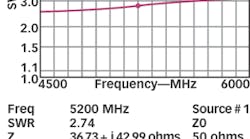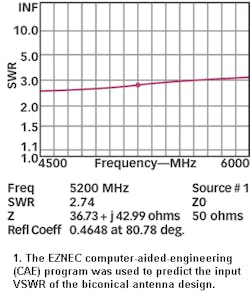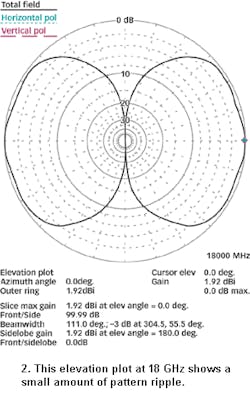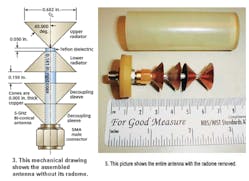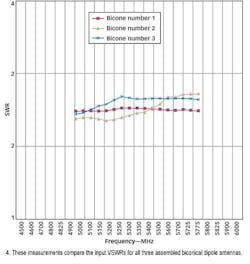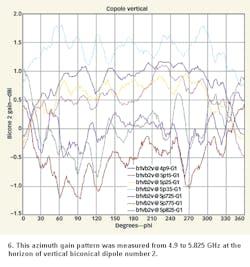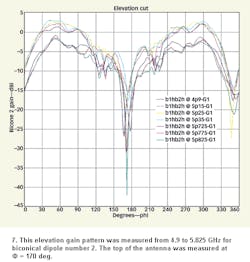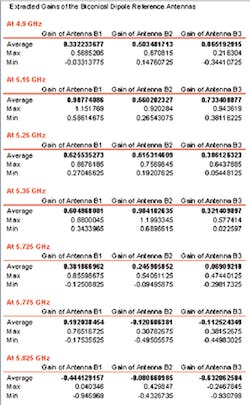Biconical dipole antennas can provide uniform omnidirectional gain in the horizontal plane and slowly varying gain with elevation across a wide frequency range. This antenna configuration was chosen for a wideband reference antenna capable of operating from 4.9 to 5.9 GHz. The antenna was designed with a center frequency of 5.3825 GHz with a 16.5 percent bandwidth to accommodate MOTOMESH technology (4.94 to 4.99 GHz) and IEEE 802.11a wideband Internet service (5.15 to 5.35 and 5.725 to 5.825 GHz).
Biconical dipole design is well documented.1-5 In general, the antenna exhibits lower characteristic impedance and wider bandwidth as the flare angle is increased. Infinite biconical antennas have constant impedance. However, end reflections cause impedance variations in finite size biconicals. The length of the dipole determines the matching resistance at its midpoint. A typical half-wave reference dipole has two radiators each about 90 electrical deg. long. A biconical antenna's length depends upon its designed matching resistance and its flare angle, and can be longer or shorter than a half-wave reference dipole. The aforementioned end reflections can be reduced using teardrop shapes intelligently, resulting in wider bandwidth.6 Since a biconical design offered acceptable bandwidth and was fast and simple to manufacture, it was chosen over developing a teardrop shaped design.
An important parameter for a biconical dipole is the product of a, the height of each cone on a vertical mounted biconical antenna, and k, the wave number, which is equal to 2p/?, where ? is the free-space wavelength. For a vertically mounted biconical dipole, this product determines how smooth the vertical cut pattern is. A preferable ka product for a reference antenna is one that produces minimal pattern ripple, typically when ka is less than 2.
Ideally, a single reference antenna could cover the entire band, since it was also desirable to use the reference antenna as a source antenna. The smallest number of reference antennas possible simplifies calibration procedures and data bookkeeping in anechoic test chambers. Also, because fewer antennas need to be positioned in the chamber, the total number of positional errors decreases.
The antennas were initially designed using the design equations in the Antenna Engineering Handbook.1 From the handbook, it was found that broadband impedance characteristics occur when the biconical antenna's flare angle lies between 60 and 120 deg. A flare angle of 90 deg. was selected as a design starting point.
In order to add build tolerance from developing gain ripple in the higher frequencies, a design frequency of 5.2 GHz was chosen below center band. Thus, the difference between the design and highest operating frequency was increased slightly. After the antennas were built, the total length of the cones could easily be reduced if needed without enlarging the ka product. The free-space wavelength of 5.2 GHz is ? ~ 5.77 cm. The value of k = 2p/? = 108.91 m1.
The characteristic impedance of a biconical dipole is a function of its flare angle and is determined by the equation:
120loge cot(?0/2)
where:
?0 = the cone half-angle.
For ?0 = 45 deg., the characteristic impedance equals about 106 O.
The input impedance of a biconical antenna is determined by its length and characteristic impedance. The input impedance will approach the characteristic impedance when the antenna length is long with respect to a wavelength. The Antenna Engineering Handbook1 contains curves of input resistance versus length and input reactance versus length for unipoles of different flare angles. The desired input resistance of the dipole design was 50 O. Using the input resistance versus length curves, the length for each cone was determined to be about 55 deg.
The ratio of degrees, 55 deg./360 deg. = 0.153 ~ 0.15, multiplied by the center frequency wavelength of 5.77 cm results in a cone height of 0.865 cm. This results in a ka value of 0.94, which is well within the ka goal of less than 2.
The EZNEC7 program, which is composed of NEC code with graphical capabilities, was used to evaluate the pattern and input impedance of the biconical design. The cones were modeled using 12 equally spaced wires per cone. The input SWR for a 50-O system is shown in Fig. 1. The design program EZNEC7 predicted a center frequency resistance of 37 O and an inductive center frequency reactance of 42 O.
A reflection coefficient of 0.4684 at 5.2 GHz (the design center frequency) corresponds to an input return loss of 6.6 dB and a transmission loss (antenna efficiency loss) of 1.1 dB. The measured return loss at 5.2 GHz was about 8.0 dB. Thus, this EZNEC7 prediction is fairly close to that measured on the prototype antennas.
Further EZNEC7 investigations were conducted to evaluate build tolerance sensitivity. Two antenna models were created. Small changes were made to the cone length of the initial design and the flare angle was reduced to 80 deg. Less than 1 dB in return loss improvement was observed.
The theoretical frequency at which the elevation cut pattern develops ripples was also examined. As shown by Fig. 2, the vertical pattern at 18 GHz has ripples of about 0.3 dB. EZNEC7 predicts exceedingly small ripples starting at 10 GHz.
The gain of the reference needed to be known at the desired frequencies in order to calibrate the chamber patterns. To determine the gain, three identical bicone antennas were fabricated. To keep the shape of the cones as consistent as possible, a cone shaped metal mandrel was fabricated by a machine shop. The cones were made out of formed thin pieces of flat copper. Each cone had one straight solder seam along one side.
The antennas were decoupled from the feed line (0.141-in.-diameter rigid coaxial cable) using two wideband decoupling cones. A 15-mil-thick fiberglass tube radome was constructed to protect the antenna. The mechanical drawing of the metal parts is shown in Fig. 3, while Fig. 5 shows one of the built antennas with the radome removed.
The end caps were made of thick fiberglass that was machined to fit into the thin sidewalls. The biconical dipole antenna has gain pattern nulls at the locations of the end caps. Thus, having sturdy end caps does not negatively impact the antenna's electrical performance. The main radiating cones and the decoupling cones were soldered as close together as possible, using a high resistance two heating element tweezer soldering station.
The measured input SWR of each biconical dipole is shown in Fig. 4.
It is very close to the simulated values determined on EZNEC7. Figure 6 shows the gain from 4.9 to 5.825 GHz at the horizon of vertically mounted biconical dipole number 2 with respect to azimuthal angle.
The corresponding "elevation cut" pattern for the same antenna is shown in Fig. 7.
The elevation plot does shows some down-tilt, which probably resulted from insufficient decoupling from the decoupling bazookas. The cross-pole gain of biconical antenna 2 has a maximum of 9 dBi at 4.9 GHz, and was typically at about 14 dBi across the band. The average cross-pole isolation is about 15 dB.
The gain of each of the three antennas was determined through a series of pathloss measurements. Using two of the biconical dipole antennas at a time and the assumption of free space pathloss existing between the antennas, three equations containing linear combinations of the gains (in dB) were derived and solved. This process was performed at seven frequencies. From the measured data, an average, maximum, and minimum gain was computed for each antenna at each measurement frequency. These values are shown in Fig. 8. The three biconical dipoles constructed had very similar gains and patterns.
8. This extracted absolute gain table (in dBi) compares the three referencebiconical dipoles.
The biconical dipole design worked well over the IEEE 802.11a WLAN band and greatly simplified the development of anechoic chamber calibration standards. The variation between the three antennas was not significant, thus build tolerances were not oppressive. No detectable elevation pattern ripple was encountered.
REFERENCES
- Richard C. Johnson and Henry Jasik, Antenna Engineering Handbook, 3rd ed., McGraw-Hill, New York, 1993.
- Constantine A. Balanis, Antenna Theory, 3rd ed., Wiley, New York, 2005.
- C.E. Smith, C.M. Butler, and K.R. Umashankar, "Characteristics of Wire Biconical Antenna," Microwave Journal, pp. 37 40, September 1979.
- G.H. Browne and O.M. Woodward, Jr., "Experimentally Determined Radiation Characteristics of Conical and Triangular Antennas," RCA Review, Vol. 13, No. 4, p. 425, December 1952.
- C.H. Papas and R. King,"Radiation from Wide-Angle Conical Antennas Fed by a Coaxial Line," Proceedings of the IRE, Vol. 39, p. 1269, November 1949.
- Seong-Youp Suh, Warren Stutzman, William Davis, Alan Waltho, and Jeffrey Schiffer, "A Novel Broadband Antenna, the Low-Profile Dipole Planar Inverted Cone Antenna (LPdiPICA)," IEEE Antennas and Propagation Society Symposium, June 2004, Vol. 1, pp. 775-778.
- EZNEC pro 4.0 Antenna Analysis Program For Windows Software, Roy Lewallen, P.E.
